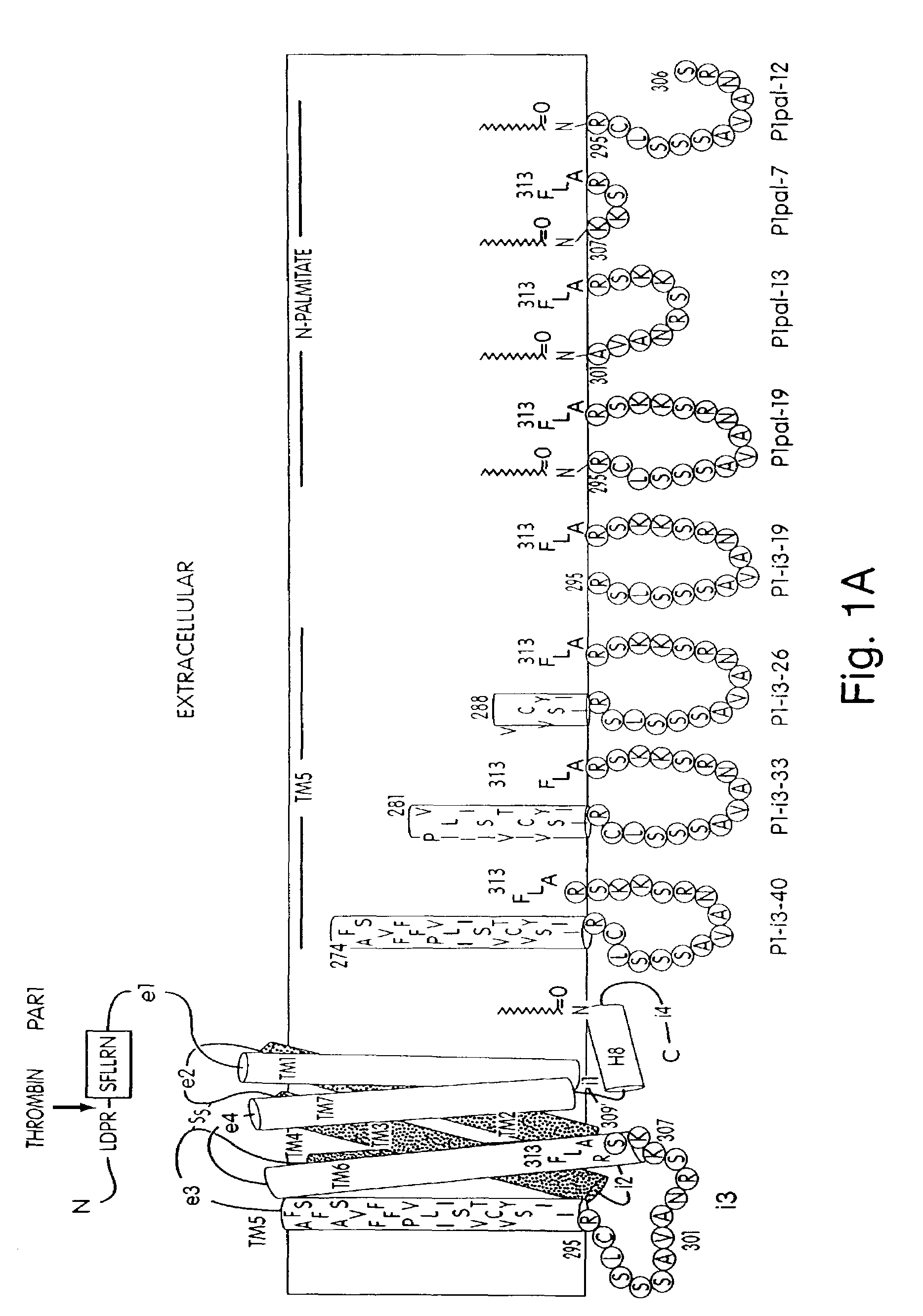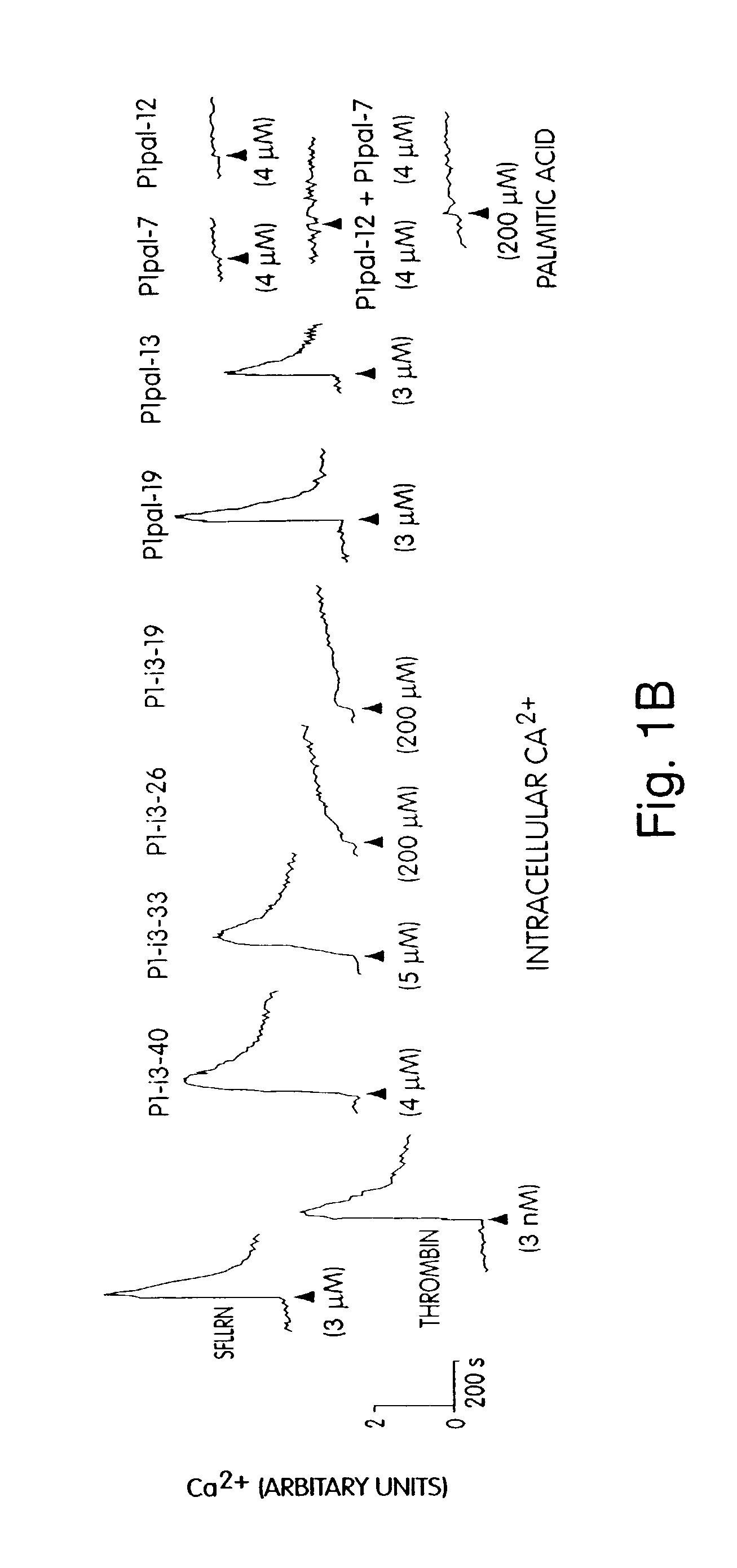G protein coupled receptor agonists and antagonists and methods of activating and inhibiting G protein coupled receptors using the same
a technology of g protein coupled receptors and antagonists, which is applied in the field of g protein coupled receptor agonists and antagonists, can solve the problems of ineffective strategies to directly study the mechanism of receptor-g protein coupling in a controlled fashion under in vivo conditions, and achieve the effects of reducing accumulation, reducing adverse side effects in subjects, and reducing accumulation
- Summary
- Abstract
- Description
- Claims
- Application Information
AI Technical Summary
Benefits of technology
Problems solved by technology
Method used
Image
Examples
example 1
Manufacture and Characterization of Pepducin Compositions
[0163]Synthesis by standard Fmoc solid phase synthetic methods and preparation of palmitoylated peptides was performed as previously described. Covic et al., PNAS 99:643-648 (2002). Palmitoylated peptides were purified to >95% purity by C18 or C4 reverse phase chromatography and dissolved in DMSO.
[0164]For human studies, whole blood was drawn from healthy volunteer donors with an 18 gauge needle into a 30 mL syringe containing 3 mL of 4% sodium citrate (0.4% v / v final). Gel-filtered human platelets were prepared as previously described. Hsu-Lin, et al., J. Biol. Chem. 259, 9121 (1984). Platelet counts were adjusted to 1.5×105 μL in modified PIPES buffer and platelet aggregation was carried out in the presence of 2.5 mM CaCl2 in final volumes of 250 μL. Platelet aggregation was measured by light scattering using a Chronolog 560VS / 490-2D aggregometer. Cytosolic calcium measurements were performed on gel-filtered human platelets ...
example 2
Assessment of the Ability of Pepducins to Activate PAR1 in a Recombinant System
[0177]Seven GPCRs were tested (PAR1, PAR2, PAR4, CCKA, CCKB, SSTR2, and MC4) for their ability to be activated or inhibited by their cognate pepducin. Full antagonist activity was demonstrated for PAR1, PAR2 (FIG. 4D), PAR4 (FIG. 4C-D), and SSTR2 ‘wild-type’ pepducins with their cognate receptors with IC50 values of 1 to 3 micromolar, as summarized in Table 2. Of these GPCRs, PAR4 is newly-discovered (Kahn et. al., Nature (London) 394:690-694 (1998); Xu et al., Proc. Natl. Acad. Sci. (USA) 95, 6642 (1998)). PAR4 was selected due to an interest in developing reagents suitable for exploring the unique ability of PAR4 to cause prolonged Ca2+ transients and irreversible platelet aggregation (Covic et al., (2000) Biochemistry 39, 5458). To date, the best extracellular ligands to PAR4 bind with millimolar or high-micromolar affinity and PAR4 inhibitors have not been reported. In FIG. 4, the anti-PAR4 pepducin, ...
example 3
Specificity of Pepducins for Other GPCRs
[0186]For these PAR1-derived i3 peptides to be useful as in vivo reagents, it was important to determine the specificity of the peptides for other GPCRs. P1pal-19 and P1pal-13 were tested for agonist activity against an array of six other GPCRs: PAR2, PAR4, cholecystokinin A and B (CCKA and CCKB), somatostatin (SSTR2), and substance P (Sub-P). COS7 cells were transiently transfected with each receptor and InsP production measured. P1pal-13 is selective for PAR1 and did not activate the other six GPCRs including PAR2 (FIG. 2E). P1pal-19 can fully activate the highly homologous PAR2 receptor and stimulates CCKB to about 30% of its maximal activity, but does not activate PAR4, CCKA, SSTR2, nor Sub-P (FIG. 2F). These data indicate that the P1pal-13 exhibits complementarity of binding to PAR1 and is highly selective. Inclusion of the six N-terminal amino acids of the i3 loop in P1pal-19 results in less selectivity.
PUM
 Login to View More
Login to View More Abstract
Description
Claims
Application Information
 Login to View More
Login to View More - R&D
- Intellectual Property
- Life Sciences
- Materials
- Tech Scout
- Unparalleled Data Quality
- Higher Quality Content
- 60% Fewer Hallucinations
Browse by: Latest US Patents, China's latest patents, Technical Efficacy Thesaurus, Application Domain, Technology Topic, Popular Technical Reports.
© 2025 PatSnap. All rights reserved.Legal|Privacy policy|Modern Slavery Act Transparency Statement|Sitemap|About US| Contact US: help@patsnap.com



